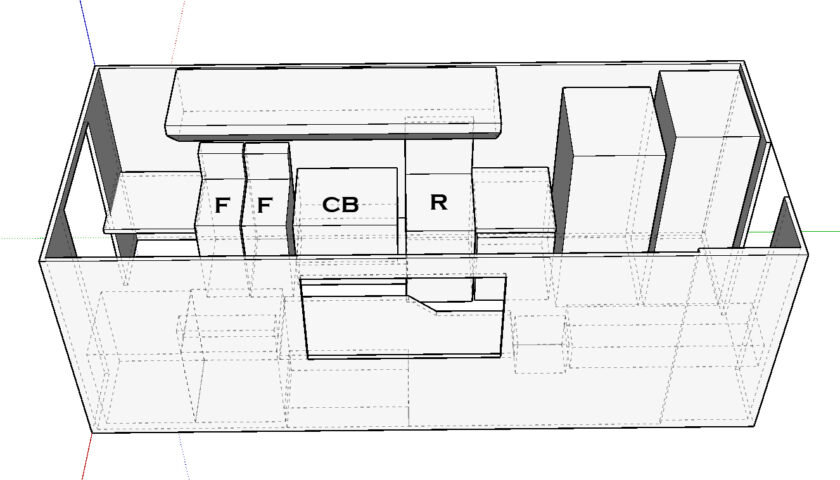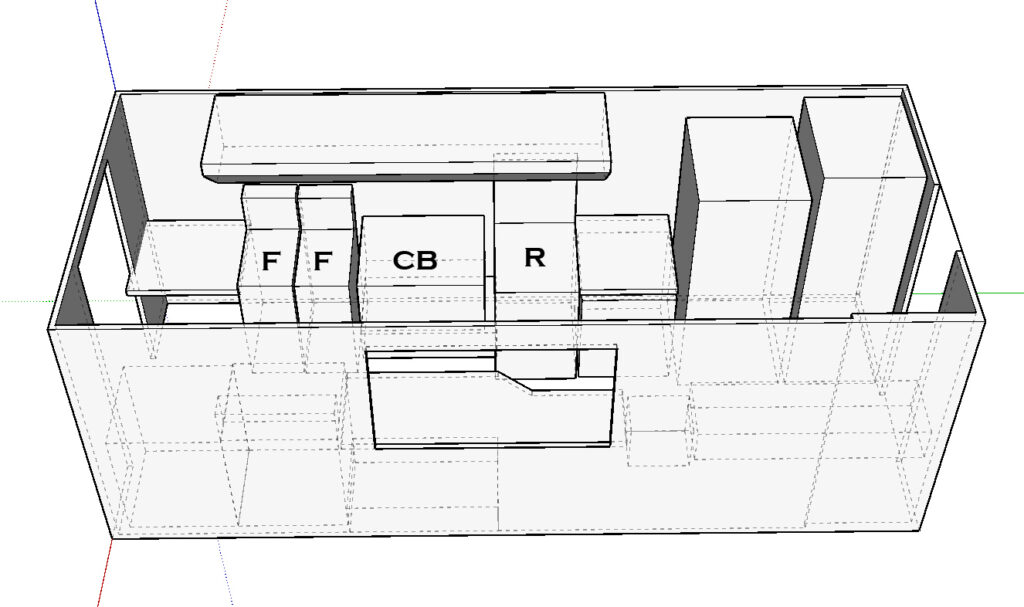
Starting a Food Truck in Rural Maine
As I’m waiting for Mother Nature to cooperate so I can start the truck build, I thought I would take a little time to share some thoughts about the past 5 month’s worth of planning. There have been a few surprises that I wasn’t expecting that could have led to serious logistical problems trying to run a food truck in rural Maine.
I’ll use the term “food truck” interchangeably with “food trailer”. I’m building a truck. Some folks reading this will be building a trailer.
The process of starting a food truck business and building your own truck is not easy or simple. The actual physical build is the easy part. The challenging part is understanding, and planning to comply with all of the fire and health safety requirements. Thankfully the Maine Health Inspection Program has published a Mobile Eating Place Operator’s Guide (PDF file). This document lists all of the statewide health safety permitting requirements for the various types of mobile food service operators. There may be additional requirements in some cities like Portland, Lewiston and Augusta.
Maine thankfully allows for fully self-contained mobile kitchens. A “mobile kitchen” has the ability to safely store, prep, cook, serve and clean the entire menu from the truck/trailer. This means that all ingredients used in preparing the full menu have to be stored at proper temperatures, that there is sufficient space to prepare and cook everything and that cooked food can be kept warm at safe temperatures for service to customers. Many states require food truck operators to store their ingredients and do their prep work in a commissary or commercial kitchen. Commissary kitchens are in very short supply in Maine, especially in rural areas. (Forked Food Lab is the only one I’m aware of. There may be others. Comment below if you know of any.)
Your mobile kitchen can’t truly be fully self-contained. You need to get your water from somewhere. And you have to dispose of waste somewhere too. These are things you should plan for before spending any money on a truck or equipment.
Water Supply
Where you get your water plays a big role in operating a food truck in rural Maine. If you’re like me and have well water you will have some extra work to do. If you have access to a public water supply the permitting process is simplified a bit. Maybe you’re lucky and live in Kingfield, Maine where the public water supply is the same stuff that goes into Poland Spring water bottles.
Maine is blessed with clean, high quality ground water resources. But what’s acceptable for your private home might not be acceptable for public consumption. Many areas of the state have high mineral content in the groundwater. Elements like arsenic are abundant and frequently beyond safe levels. You should get your intended water supply tested. The testing requirements are in the Mobile Eating Place Operator’s Guide linked above. If your water meets the testing requirements you will be permitted to use it for washing and cooking but it can’t be used for any uncooked items. i.e. you can’t serve a lemonade mix with your well water. Any water intended for consumption (ice too!) must come from an approved public water supply. This could pose a problem for some food trucks. It’s something you should investigate early in the process. I got lucky. My water is very high quality. I didn’t get around to testing my water until I was well into the planning process. It could have become a big problem for me. It would be a huge inconvenience to have to drive to a public water supply location to fill the fresh water holding tank.
I’m not planning to serve any drinks or menu items incorporating water from my well. I simply don’t have the space or time to handle drinks when filling orders. All drinks sold at Smoked Food Truck will be pre-packaged. That was my plan from the beginning so the well water restriction doesn’t impact my business plan. Your businesses’ needs may be different.
Waste Water
Where are you going to dispose of the water from washing dishes and food prep? This can pose a serious logistical hurdle. The requirements are spelled out in the Mobile Eating Place Operators Guide. I suspect most people starting a food truck in rural Maine will want to use their home septic system for wastewater discharge. In order to do so you need to contact your Local Plumbing Inspector (LPI) and have them review your septic system design to be sure it’s capable of handling the increased use. There’s a good chance your septic system design might not be able to accept the extra load. In my case I got lucky. My truck will generate a max of 50 gallons of wastewater per day. My home’s septic system is designed to meet the load of a 3 bedroom house. The LPI for my area reviewed my septic plans and approved my system with additional restrictions: a grease trap must be installed in the truck and 2) the house can only be used as a 2 bedroom. These restrictions are a not problem for me but could be for some people.
Dishwashing Requirements
Depending on your menu and the types of food you’re serving your mobile kitchen will be required to have a 2-bay or 3-bay sink with drainboards. I need a 3-bay because I’m working with raw meat. There’s not a lot of room in a food truck. A sink will consume a big chunk of your square footage. (You are also required to have a dedicated hand washing sink that’s not used for anything else.) The bays in the sink need to be sized so the largest pot/pan/plate/utensil can be fully submerged. This simple requirement is actually a significant piece of the puzzle. Are you going to use full-sized sheet pans? They’re 25″ x 17″. That’s a big sink bay, and multiply that by 3 and add the drainboards left and right. You’ll end up with a huge sink. If your space is large enough for a huge sink that’s awesome. I bought the truck before I understood this requirement. So I had to approach things a bit differently. I have a limited area available for a sink because of all of the other equipment in the truck. Based on my menu I needed to plan the sizes of cooking containers that would fit into the sink bays. And if there’s an instance of something that won’t fit are there disposable options available? An example is a foil pan for a full brisket. Too big to fit in the sink but it’s disposable and doesn’t require washing.
Another thing to consider are the water temperatures required for hand washing and dish/ware washing. If you’re using an on-demand hot water heater be sure it has enough output to raise the water temp in the storage tank to reach 110 degrees F. The water in the storage tank will typically be at ambient temp. In the spring/fall that could be as low as 45 degrees. In this example the on-demand hot water heater needs to be able to raise the temp of the water by 65 degrees. That’s a lot of BTUs. Be aware of this when planning your hot water system.
Ventilation Hood and Fire Suppression
Maine requires food trucks to have a commercial ventilation hood with an integrated fire suppression system. This requirement is not something you’ll find in the Mobile Eating Place Operator’s Guide because it’s a Fire Marshall/Life Safety code issue, not a health safety code issue. In the larger cities like Portland, South Portland and Lewiston there are inspections to be sure your truck meets all fire safety code requirements. At this time, in the other areas of the state there are no inspections but the truck needs to be built in compliance. In the future the state Fire Marshal’s office may implement an inspection program so it’s best to do it right from the start. You also might find that your insurance provider will have requirements that must be met as well.
The hood and fire suppression system is the most expensive piece of equipment in my truck. I picked up a 9 foot hood with fire suppression from Hood Mart in Elyria, OH. Saved myself almost $900 in shipping costs by picking it up at the factory. This system comes pre-plumbed with all of the correct fire suppression components for the cooking equipment below. In my opinion it’s well worth the additional cost to have it done right instead of trying to figure all of it out on my own. Life safety issues are best left to the professionals.
Certified Food Protection Manager (CFPM)
All restaurants in Maine require a Certified Food Protection Manager. This is a certification that covers food safety issues. The CFPM’s certificate number is part of the application process for a mobile kitchen. I recommend completing the coursework prior to starting your food truck build. (I didn’t do this.) The knowledge gained in the course will help you properly determine your equipment needs and layout your space properly to support the menu items you plan to serve. How you store your raw ingredients and cooked foods will determine a lot about the type and sizes of equipment you’ll need in your truck. Here’s a list of approved CFPM courses. (Opens PDF on Maine.gov site)
These are just a few of the issues you’ll need to contend with when planning a food truck build in rural Maine. In my opinion, they’re the ones you should find solutions to before spending any money on forming the business or buying the truck/trailer. I got lucky. It’s all going to work out for me. You might be in a completely different situation. I’ll be posting videos of the build where I talk about these issues on the Smoked Food Truck YouTube Channel.

